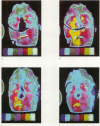Abstract
The development of a facial flush during thermocoagulation of the Gasserian ganglion was monitored in 16 patients with pulse recording techniques and in a further 17 patients with thermography. There was a close association between the development of the facial flush in the distribution of one or more divisions of the trigeminal nerve and the subsequent demonstration of postoperative analgesia. In regions where significant changes took place, vascular pulsations increased 25-233% (mean 96%) and facial temperature rose 0.5-2.0 degrees C. The response persisted for up to an hour postoperatively, and was not diminished in patients with pre-operative analgesia from a previous procedure. Possible mechanisms for the facial flush, including stimulation of an active vasodilator system, the antidromic release of vasoactive substances from trigeminal nerve terminals and the release of tonic vasoconstriction are discussed. A practical application of the pulse recording technique used in the present investigation would be to monitor the distribution of vasodilatation at operation to avoid unwanted first division sensory loss.
Full text
PDF





Images in this article
Selected References
These references are in PubMed. This may not be the complete list of references from this article.
- BARLOW C. M., ROOT W. S. The ocular sympathetic path between the superior cervical ganglion and the orbit in the cat. J Comp Neurol. 1949 Oct;91(2):195-207, illust. doi: 10.1002/cne.900910203. [DOI] [PubMed] [Google Scholar]
- Bill A., Stjernschantz J., Mandahl A., Brodin E., Nilsson G. Substance P: release on trigeminal nerve stimulation, effects in the eye. Acta Physiol Scand. 1979 Jul;106(3):371–373. doi: 10.1111/j.1748-1716.1979.tb06412.x. [DOI] [PubMed] [Google Scholar]
- Brodin E., Gazelius B., Lundberg J. M., Olgart L. Substance P in trigeminal nerve endings: occurrence and release. Acta Physiol Scand. 1981 Apr;111(4):501–503. doi: 10.1111/j.1748-1716.1981.tb06770.x. [DOI] [PubMed] [Google Scholar]
- Drummond P. D., Lance J. W. Extracranial vascular reactivity in migraine and tension headache. Cephalalgia. 1981 Sep;1(3):149–155. doi: 10.1046/j.1468-2982.1981.0103149.x. [DOI] [PubMed] [Google Scholar]
- FOX R. H., GOLDSMITH R., KIDD D. J. Cutaneous vasomotor control in the human head, neck and upper chest. J Physiol. 1962 May;161:298–312. doi: 10.1113/jphysiol.1962.sp006887. [DOI] [PMC free article] [PubMed] [Google Scholar]
- Gonzalez G., Onofrio B. M., Kerr F. W. Vasodilator system for the face. J Neurosurg. 1975 Jun;42(6):696–703. doi: 10.3171/jns.1975.42.6.0696. [DOI] [PubMed] [Google Scholar]
- Jancsó N., Jancsó-Gábor A., Szolcsányi J. Direct evidence for neurogenic inflammation and its prevention by denervation and by pretreatment with capsaicin. Br J Pharmacol Chemother. 1967 Sep;31(1):138–151. doi: 10.1111/j.1476-5381.1967.tb01984.x. [DOI] [PMC free article] [PubMed] [Google Scholar]
- Matthews B., Robinson P. P. The course of post-ganglionic sympathetic fibres distributed with the trigeminal nerve in the cat. J Physiol. 1980 Jun;303:391–401. doi: 10.1113/jphysiol.1980.sp013294. [DOI] [PMC free article] [PubMed] [Google Scholar]
- Moskowitz M. A., Reinhard J. F., Jr, Romero J., Melamed E., Pettibone D. J. Neurotransmitters and the fifth cranial nerve: is there a relation to the headache phase of migraine? Lancet. 1979 Oct 27;2(8148):883–885. doi: 10.1016/s0140-6736(79)92692-8. [DOI] [PubMed] [Google Scholar]
- Onofrio B. M. Radiofrequency percutaneous Gasserian ganglion lesions. Results in 140 patients with trigeminal pain. J Neurosurg. 1975 Feb;42(2):132–139. doi: 10.3171/jns.1975.42.2.0132. [DOI] [PubMed] [Google Scholar]
- Parkinson D., Johnston J., Chaudhuri A. Sympathetic connections to the fifth and sixth cranial nerves. Anat Rec. 1978 Jun;191(2):221–226. doi: 10.1002/ar.1091910207. [DOI] [PubMed] [Google Scholar]
- Sweet W. H., Wepsic J. G. Controlled thermocoagulation of trigeminal ganglion and rootlets for differential destruction of pain fibers. 1. Trigeminal neuralgia. J Neurosurg. 1974 Feb;40(2):143–156. doi: 10.3171/jns.1974.40.2.0143. [DOI] [PubMed] [Google Scholar]



